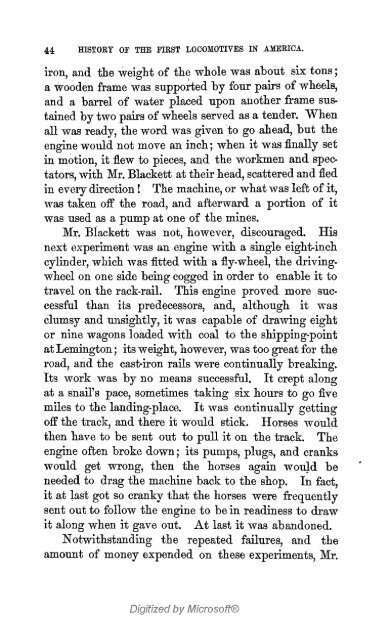The history of the first locomotives in America. From original ...
The history of the first locomotives in America. From original ...
The history of the first locomotives in America. From original ...
You also want an ePaper? Increase the reach of your titles
YUMPU automatically turns print PDFs into web optimized ePapers that Google loves.
44<br />
HISTOKT OF THE FIRST LOCOMOTIVES IN AMERICA.<br />
iron, and tlie weight <strong>of</strong> <strong>the</strong> whole was atout six tons<br />
a \ivooden frame was supported by four pairs <strong>of</strong> wheels,<br />
and a barrel <strong>of</strong> water placed upon ano<strong>the</strong>r frame susta<strong>in</strong>ed<br />
by two pairs <strong>of</strong> wheels served as a tender. When<br />
all was ready, <strong>the</strong> word was given to go ahead, but <strong>the</strong><br />
eng<strong>in</strong>e would not move an <strong>in</strong>ch ; when it was f<strong>in</strong>ally set<br />
<strong>in</strong> motion, it flew to pieces, and <strong>the</strong> workmen and spec-<br />
tators, with Mr. Blackett at <strong>the</strong>ir head, scattered and fled<br />
<strong>in</strong> every direction ! <strong>The</strong> mach<strong>in</strong>e, or what was left <strong>of</strong> it,<br />
was taken <strong>of</strong>f <strong>the</strong> road, and afterward a portion <strong>of</strong> it<br />
was used as a pump at one <strong>of</strong> <strong>the</strong> m<strong>in</strong>es.<br />
Mr. Blackett was not, however, discouraged. His<br />
next experiment was an eng<strong>in</strong>e with a s<strong>in</strong>gle eight-<strong>in</strong>ch<br />
cyl<strong>in</strong>der, which was fitted with a fly-wheel, <strong>the</strong> driv<strong>in</strong>g-<br />
wheel on one side be<strong>in</strong>g cogged <strong>in</strong> order to enabk it to<br />
travel on <strong>the</strong> rack-rail. This eng<strong>in</strong>e proved more successful<br />
than its predecessors, and, although it was<br />
clumsy and unsightly, it was capable <strong>of</strong> draw<strong>in</strong>g eight<br />
or n<strong>in</strong>e wagons loaded with coal to <strong>the</strong> shipp<strong>in</strong>g-po<strong>in</strong>t<br />
at Lem<strong>in</strong>gton ; its weight, however, was too great for <strong>the</strong><br />
road, and <strong>the</strong> cast-iron rails were cont<strong>in</strong>ually brealdng.<br />
Its work was by no means successful. It crept along<br />
at a snail's pace, sometimes tak<strong>in</strong>g six hours to go five<br />
miles to <strong>the</strong> land<strong>in</strong>g-place. It was cont<strong>in</strong>ually gett<strong>in</strong>g<br />
<strong>of</strong>f <strong>the</strong> track, and <strong>the</strong>re it would stick. Horses would<br />
<strong>the</strong>n have to be sent out to pull it on <strong>the</strong> track. <strong>The</strong><br />
eng<strong>in</strong>e <strong>of</strong>ten broke down ; its pumps, plugs, and cranks<br />
would get wrong, <strong>the</strong>n <strong>the</strong> horses aga<strong>in</strong> would be<br />
needed to drag <strong>the</strong> mach<strong>in</strong>e back to <strong>the</strong> shop. In fact,<br />
it at last got so cranky that <strong>the</strong> horses were frequently<br />
sent out to follow <strong>the</strong> eng<strong>in</strong>e to be <strong>in</strong> read<strong>in</strong>ess to draw<br />
it along when it gave out. At last it was abandoned.<br />
Notwithstand<strong>in</strong>g <strong>the</strong> repeated failures, and <strong>the</strong><br />
amount <strong>of</strong> money expended on <strong>the</strong>se experiments, Mr.<br />
Digitized by Micros<strong>of</strong>t®<br />
;
















